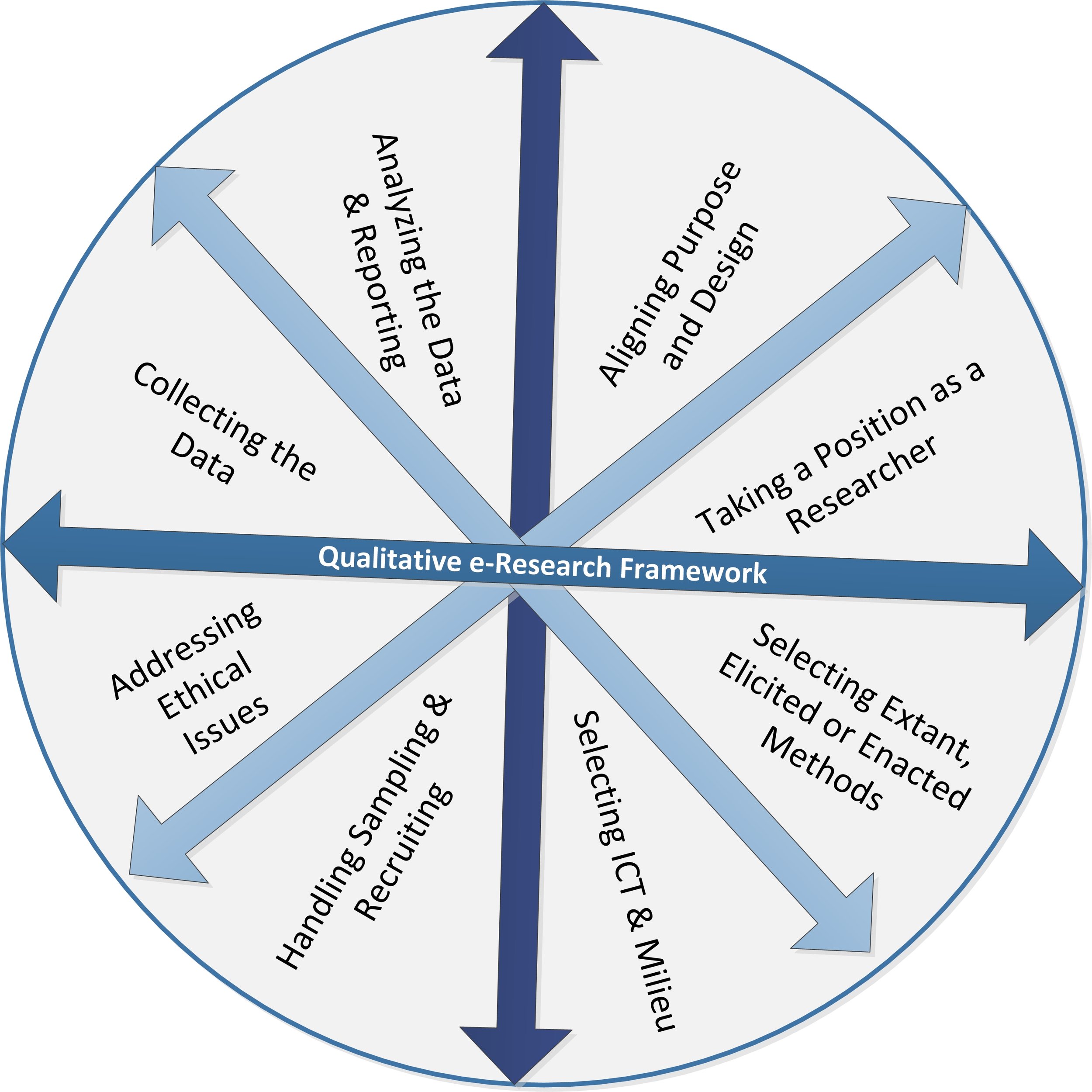Studying Vlogs and Blogs
By Janet Salmons, Ph.D.
Dr. Salmons is the author of Doing Qualitative Research Online, and Gather Your Data Online. Use the code COMMUNIT24 for 25% off through December 31, 2024 if you purchase research books from Sage.
You are reading about blogs on a blog, (written by a blogger)!
Post your ideas on a blog - it will be one of 6 million new posts made every day!
Written blogs and video blogs or vlogs are a part of the digital ecosystem. Hookway (2019) observed:
Blogs are the quintessential early 21st century text blurring the boundary between private and public…. The defining features of blogs are “frequency, brevity and personality” (Turnbull, 2002, p. 82). More formally, a “blog” refers to a website that contains a series of frequently updated, reverse chronologically ordered posts on a common web page, usually written by a single author (Hookway, 2008). Blogs are treated as multimedia “documents of life” that offer unique personal accounts of everyday life and provide large amounts of instantaneous data that are global, archived, searchable, and relatively resource-lite.
Blogs became popular in the early 2000s and while other forms of communication and interaction have emerged since then, blogs are still with us. According to business blogger Luisa Zhou, there are over 600 million blogs online and over 6 million new posts are published every day! That is a lot of material, many “documents of life” available for study. In this collection of open-access articles you can find examples and suggestions of studies that examined video- or text-based blogs.
Vlogs
Dewantara, M. H., Jin, X., & Gardiner, S. (2023). What makes a travel vlog attractive? Parasocial interactions between travel vloggers and viewers. Journal of Vacation Marketing, 0(0). https://doi.org/10.1177/13567667231186554
You can find this previous post about using blogs to disseminate your research: Share Your Research: Blog and/or Social Media, and this post Research Uses for Blogs.
Abstract. This study seeks to understand how vlogger attributes, as defined in parasocial interaction (PSI) theory, can be used to create a successful travel vlog and assist in destination vacation marketing. Using social media content analysis, validated by the nominal group technique, the study found that the vlogger's physical attractiveness is important, however, other factors including social, task, and destination attractiveness also influence the attractiveness of the vlog to the viewer. The vlogger's credibility, attitude homophily, and technology skills can also make the vlog more attractive. The study also shows that travel vloggers can employ PSIs to arouse viewers’ intentions to travel. The COVID-19 pandemic context elaborates more PSI attributes in the travel vlog and makes travel vloggers explore external social interaction with the host society.
Duan, X. (2020). “The Big Women”: A textual analysis of Chinese viewers’ perception toward femvertising vlogs. Global Media and China, 5(3), 228-246. https://doi.org/10.1177/2059436420934194
Abstract. Video blogging (vlogging), a type of short video that people produce by recording and editing their daily lives, has become an emerging form of digital cultural production on social media platforms in China. With the profound growth of video marketing on social platforms, brands have increasingly leveraged vloggers to promote female-targeted products. This phenomenon becomes especially paradoxical when marketers bring the narrative of female empowerment into the discourse. This case study employed textual analysis to understand how Chinese viewers make sense of Bobbi Brown’s “The Big Women” vlog endorsed by the female vlogger Zhuzi on Weibo. A typology of viewers’ response was generated: (1) reciprocity of self-disclosure; (2) perceived interconnectedness with the vlogger; and (3) perceived women empowerment and advertisement effectiveness. The findings of this article articulate a symbolic form of relationship between content creators, brands, and consumers that promotes women empowerment. This study argues, however, that this perception of women empowerment may obscure the implicit consumerism embedded in the femvertising contents, while promoting the myth of self-empowerment through consumption. The findings of the study shed light on the rise of (pseudo-)feminism ethos constructed by the consumer market in contemporary China and beyond.
Goedhart, N. S., Lems, E., Zuiderent-Jerak, T., Pittens, C. A. C. M., Broerse, J. E. W., & Dedding, C. (2022). Fun, engaging and easily shareable? Exploring the value of co-creating vlogs with citizens from disadvantaged neighbourhoods. Action Research, 20(1), 56-76. https://doi.org/10.1177/14767503211044011
Abstract. The use of vlogs is promising in participatory action research (PAR) that aims to enhance the health and well-being of citizens. Vlogs have the potential to reach a wide audience, transcending the local scale of PAR. This article aims to explore the value of co-creating vlogs by investigating two exploratory studies involving adolescents and women from disadvantaged neighbourhoods. We reflected on the co-creation of vlogs by community members and professionals. The results show that co-creating vlogs enabled meaningful engagement of citizens living in vulnerable circumstances and promoted shared learning. Community members who were not involved in the vlog creation were critical of the vlogs. However, watching the vlogs stimulated discussion and reflection. Therefore, dissemination of vlogs in a setting guided by a professional seems to have the potential to facilitate shared learning. Despite the popularity of vlogs, this study highlights the need to carefully consider the use of vlogs in relation to a study’s aims and to respond to (ethical) concerns.
Hassan, R. H. (2023). Educational Vlogs: A Systematic Review. Sage Open, 13(1). https://doi.org/10.1177/21582440231152403
Abstract. This article presents a systematic review of the literature on the role of educational vlogging in enhancing learning and teaching outcomes. The researcher analyzed a total of 60 papers published from 2011 to 2021 using qualitative analysis with complementary quantitative analysis. The findings shed light on the vital role of vlogging in education over the last decade. This systematic review provides scholars and practitioners in the fields of education and educational technology with valuable information about how to improve learning and teaching through vlogging. The data was collected using the Preferred Reporting Items for Systematic Reviews and Meta-Analysis (PRISMA) method. The findings indicated that students and teachers have a positive attitude toward vlogging. Vlogging in higher education is more extensive than in K-12. The main subject in which vlogging is used in K-12 was language, while the main subject in higher education (HE) was found to be reflective practices.
Wang, X. (2022). Popularising Vlogging in China: Bilibili’s Institutional Promotion of Vlogging Culture. Global Media and China, 7(4), 441-462. https://doi.org/10.1177/20594364221133536
Abstract. Vlogging culture has experienced rapid growth in China since 2018. Central to this expansion, social media platforms have played a dominant role in popularising vlogging culture. By conducting a digital ethnography of the Chinese user-generated content platform Bilibili from September 2019 to May 2022, this article explores the institutional power of platforms in promoting and shaping vlogging production and practices in China. Beyond the function of intermediating, Bilibili shapes vlogging as an intensive production and interactive practice with high performativity to compete for visibility. This article theorises four ways that Bilibili popularises vlogging culture in China: pillarising discourses, metric-based monetisation, advertising mediation and vlog-focused campaigns. In taking this approach, this study sheds light on the institutional power of platforms in promoting and shaping cultural production. In addition, it uncovers the precarity embedded in the promotion strategies, notably the interplay with the platform economy in the context of China.
Xiang, Y. (2019). User-generated news: Netizen journalism in China in the age of short video. Global Media and China, 4(1), 52-71. https://doi.org/10.1177/2059436419836064
Abstract. As media technology advances, and with increasingly rapid development, there has been an unprecedented growth in the number of new media platforms emerging in China—and throughout the world—that are changing the procedures of how news is assembled and disseminated by effectively and efficiently adopting user-generated content that has injected new blood into the very nature of journalism. While essentially this is encouraging the productive use of social media platforms, it is also having an impact on users, transforming vast numbers into what are now recognized as “netizen journalists.” This leads us to inquire just how the journalistic outputs of short video platforms of such media outfits like Pear Video and Kwai are framed and also to explore how the roles of the “ordinary” users of such platforms are now defined by their participation in the actual production of news and information. This research aims to contribute to the many discussions on the above questions based on the journalistic study on three different news platforms: Xinhua News Agency’ as adopted and adapted content from Kwai, Kwai Insight, and Pear Video.
Blogs
Alzahrani, A. I., Ramayah, T., Suppiah, N., Alfarraj, O., & Alalwan, N. (2020). Modeling Blog Usage From a Developing Country Perspective Using Structural Equation Modeling (SEM). Sage Open, 10(3). https://doi.org/10.1177/2158244020947104
Abstract. The manner in which activities are now conducted online has largely transformed as a result of the prevalent digitally rich environment. With the evolution of the Internet, channels utilized for knowledge and information sharing have also changed. Both organizations and individuals have largely benefited from the use of various Web 2.0 features. Innovative interaction channels are now available, and the concept is increasingly being applied to other areas. Social networking opportunities have increased manifold, and different kinds of web technologies are being utilized for communication. The online community has also embraced the multi-interactive dimension of Web 2.0, as inherent in various blogging activities. This study analyzed why people choose to engage in web technologies such as blogging. As the growth of web technology is rather parallel with that of digital marketing, the research also focused on how these aspects can enhance marketing strategies in the future. The results of the study have various implications, as marketing is significantly influenced by blog readers’ level of engagement, including word-of-mouth marketing, purchasing decisions, and even brand building. Both awareness and trust play significant roles in the process, and they are often utilized to justify the risk inherent in the online environment.
Geuze L, Goossensen A. Exploring the Experiences of Dutch Parents Caring for Children with Profound Intellectual and Multiple Disabilities: A Thematic Analysis of Their Blogs. Global Qualitative Nursing Research. 2021;8. doi:10.1177/23333936211028170
Abstract. The current study analyzed blogs written by four Dutch parents of children with profound intellectual and multiple disabilities, with the aim of deepening the understanding of the parents’ concerns. Thematic analysis was conducted and five main themes were identified: Dealing with uncertainties addressed the impact of unpredictability present in the everyday lives of parents, Love and loss described the complexity of concurrently cherishing the child and grieving various types of loss, Struggling with time, energy and finances detailed imbalances and struggles related to parents’ personal resources, Feeling included in communities and society specified social consequences, and Relating to professional care services reflected on stress and support associated with professional care delivery. The study findings demonstrate how care professionals should acknowledge parents’ vulnerabilities by being aware of their existential distress and empowering parents to exercise control of family thriving.
Haimson, O. L. (2020). Challenging “Getting Better” Social Media Narratives With Intersectional Transgender Lived Experiences. Social Media + Society, 6(1). https://doi.org/10.1177/2056305120905365
Abstract. A dominant media narrative of “getting better” over time is often projected onto LGBTQ people’s personal life experiences. In this research study, I examine this narrative’s role in transgender people’s emotional well-being throughout transition. A “getting better” narrative was pervasive in my qualitative analysis of 240 Tumblr transition blogs and 20 interviews with bloggers, signaling that it impacted people’s self-concept both as presented on social media and when talking about their experiences. This narrative causes undue emotional harm given contrast between one’s post-transition reality, which may involve distress (despite greater congruence between one’s body and identity), and a dominant cultural expectation of happiness. I argue that an intersectional approach to understanding trans people’s emotional well-being—by considering multiple salient identity facets and life transitions—makes trans lives more livable by complicating the cultural imperative to feel better, and to present a unilaterally positive self-image online, post-transition. Even though trans people on average feel better after gender transition, everyday realities are often in contrast to the dominant narrative’s positioning of gender transition as a process with a single, simple goal of feeling better. Challenging the “getting better” narrative gives trans people the freedom to live and exist in their post-transition identities, whether or not they feel “better.”
Meier-Vieracker, S. (2024). Racist discourse in a German far-right blog: A corpus-driven approach using word embeddings. Discourse & Society, 35(2), 223-242. https://doi.org/10.1177/09579265231204510
Abstract. Newer forms of racism in the context of right-wing extremism are characterised by an apparent distancing from overt racist devaluations. In addition or even beyond biological features, it is now cultural characteristics attributed to social groups which serve as grounds for practices of othering and social exclusion. This paper analyses racist discourse in the comment sections of the influential far-right blog pi-news.com where these practices can be observed in detail. With reference to discourse analytical approaches to racism and using corpus-linguistic, data-driven methods, especially word embeddings and collocations, it is shown how racism is linguistically and discursively expressed. Next to both overt and more implicit racist nominations and predications, the notion of Heimat (‘homeland’) is analysed; it is used to draw racist demarcations without relying on overtly racialising terms.
van Eck, C. W., Mulder, B. C., & Dewulf, A. (2020). Online Climate Change Polarization: Interactional Framing Analysis of Climate Change Blog Comments. Science Communication, 42(4), 454-480. https://doi.org/10.1177/1075547020942228
Abstract. While increasingly more is known about how to reframe the relevance of climate change, much less is known about how people deal with situations in which they are confronted with frames that are incompatible with their own frames. The current research conducts an interactional framing analysis to investigate how users in climate change blog comments interactively construct the meaning of issues, identities and relationships, and their interactions. Results show that most framing differences start with issue framing but thereafter shift to identity and relationship or process framing. Finally, users mostly deploy polarizing interaction strategies to deal with these framing differences.
Wang, Y.-M., & Chiou, C.-C. (2022). Empirically Examining the Effectiveness of Teaching Blogs on University Course Instruction. Sage Open, 12(3). https://doi.org/10.1177/21582440221104782
Abstract. Blogs have the potential to be integrated as learning tools to help students learn and reflect. Many educators have incorporated the use of teaching blogs to enhance teaching and learning outcomes in higher education settings. However, research conducted to empirically examine the effectiveness of blog use in education is rare. This study intends to help fill the remaining gaps in the research; there are two main purposes: (1) to examine, using a field quasi-experiment, whether the use of teaching blogs in university course instruction enhances student learning outcomes; and (2) to empirically understand the determinants and impacts of the extent of student blog use on university’s course learning via a questionnaire analysis. Two separate studies were conducted. The experimental results of Study 1 show that using teaching blogs not only enhances learner satisfaction, but also increases university students’ learning achievement. The Study 2 results show that higher quality teaching blogs positively influence the extent of student blog use, which in turn positively influences student learning satisfaction and achievement. This study extends our knowledge and insights regarding the use of teaching blogs within the higher education domain.
Willment, N. (2023). ‘Audiencing’ the travel blog: Examining how practices of audiencing influence the affective labour of travel bloggers online. New Media & Society, 0(0). https://doi.org/10.1177/14614448231193982
Abstract. This article demonstrates how applying the concept of audiencing allows us to better understand how the presence of different audiences online mediates the affective labour practices of content creators. The article focuses on one distinctive example of online content creators: British travel bloggers. First, the article argues that audiencing provides an important lens to witness the diversity of affective labour practices being undertaken by travel bloggers, contributing to the wider literature around affective work. Second, the article also demonstrates how travel bloggers are an important focus of study, as they utilise visual and narrative experiences of place as the key foci through which they tailor their affective work to different relationships of audiencing. This finding contributes to the labour on audiencing, by demonstrating how creative labourers use a stimulus (such as discussions of place) as a mechanism through which to tailor their affective work.
Hookway, N., (2019). Blog Analysis, In P. Atkinson, S. Delamont, A. Cernat, J.W. Sakshaug, & R.A. Williams (Eds.), SAGE Research Methods Foundations. https://doi.org/10.4135/9781526421036801324































The wealth of material available online is irresistible to social researchers who are trying to understand contemporary experiences, perspectives, and events. The ethical collection and -use of such material is anything but straightforward. Find open-access articles that explore different approaches.